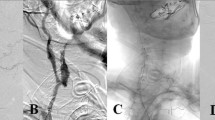Abstract
Post-radiotherapy carotid blowout syndrome (CBS) of the skull base is a rare but often catastrophic complication of head and neck malignancies. The existing literature on the treatment of this condition with flow-diverting devices (FDD) is extremely limited and disappointing. We present a case of impending CBS in a patient previously irradiated for nasopharyngeal cancer that was successfully treated with use of multiple FDDs, adjunctive endonasal packing and delayed reinforcement with pedicled naso-septal flap, yielding an excellent outcome at 14-months follow-up. Notwithstanding the discouraging results in literature, our anecdotal experience suggests that endovascular reconstruction using FDD could be an option with long-term viability in post-radiotherapy CBS involving the skull base when reinforced with a vascularised naso-septal flap.


Similar content being viewed by others
References
Chaloupka JC, Putman CM, Citardi MJ, Ross DA, Sasaki CT (1996) Endovascular therapy for the carotid blowout syndrome in head and neck surgical patients: diagnostic and managerial considerations. AJNR Am J Neuroradiol 17(5):843–852
Wan WS, Lai V, Lau HY, Wong YC, Poon WL, Tan CB (2013) Endovascular treatment paradigm of carotid blowout syndrome: review of 8-years experience. Eur J Radiol 82(1):95–99
Wong GK, Poon WS (2013) Why current evidence is against flow diverters for treatment of carotid blowout syndrome. Eur J Radiol 82(1):191
Tsang AC, Leung KM, Lee R, Lui WM, Leung GK (2015) Primary endovascular treatment of post-irradiated carotid pseudoaneurysm at the skull base with the pipeline embolization device. J Neurointerv Surg 7(8):603–607
Shah H, Gemmete JJ, Chaudhary N, Pandey AS, Ansari SA (2011) Acute life-threatening hemorrhage in patients with head and neck cancer presenting with carotid blowout syndrome: follow-up results after initial hemostasis with covered-stent placement. AJNR Am J Neuroradiol 32(4):743–747
Sylvester PT, Moran CJ, Derdeyn CP, Cross DT, Dacey RG, Zipfel GJ et al (2016 Nov) Endovascular management of internal carotid artery injuries secondary to endonasal surgery: case series and review of the literature. J Neurosurg 125(5):1256–1276
Lai V, Wan WS (2013) Reply to letter to the editor “why current evidence is against flow diverters for treatment of carotid blowout syndrome”. Eur J Radiol 82(1):192
Chen KC, Yen TT, Hsieh YL, Chen HC, Jiang RS, Chen WH et al (2015) Postirradiated carotid blowout syndrome in patients with nasopharyngeal carcinoma: a case-control study. Head Neck 37(6):794–799
Lam JW, Chan JY, Lui WM, Ho WK, Lee R, Tsang RK (2014) Management of pseudoaneurysms of the internal carotid artery in postirradiated nasopharyngeal carcinoma patients. Laryngoscope 124(10):2292–2296
Adel M, Chang KP (2016) Using a nasoseptal flap for the reconstruction of osteoradionecrosis in nasopharyngeal carcinoma: a case report. J Otolaryngol Head Neck Surg 45:27
Author information
Authors and Affiliations
Corresponding author
Ethics declarations
Funding
No funding was recieved.
Conflict of interest
The authors declare that they have no conflict of interest.
Ethical review
No ethics committee approval required for case reports at our institute.
Informed consent
Informed consent was obtained from the patient for publishing this as a case report.
Rights and permissions
About this article
Cite this article
Anil, G., Zhang, J., Ong, Y.K. et al. Flow-diverter in radiation-induced skull base carotid blowout syndrome: do not write it off!. Neurosurg Rev 40, 685–688 (2017). https://doi.org/10.1007/s10143-017-0875-3
Received:
Revised:
Accepted:
Published:
Issue Date:
DOI: https://doi.org/10.1007/s10143-017-0875-3




